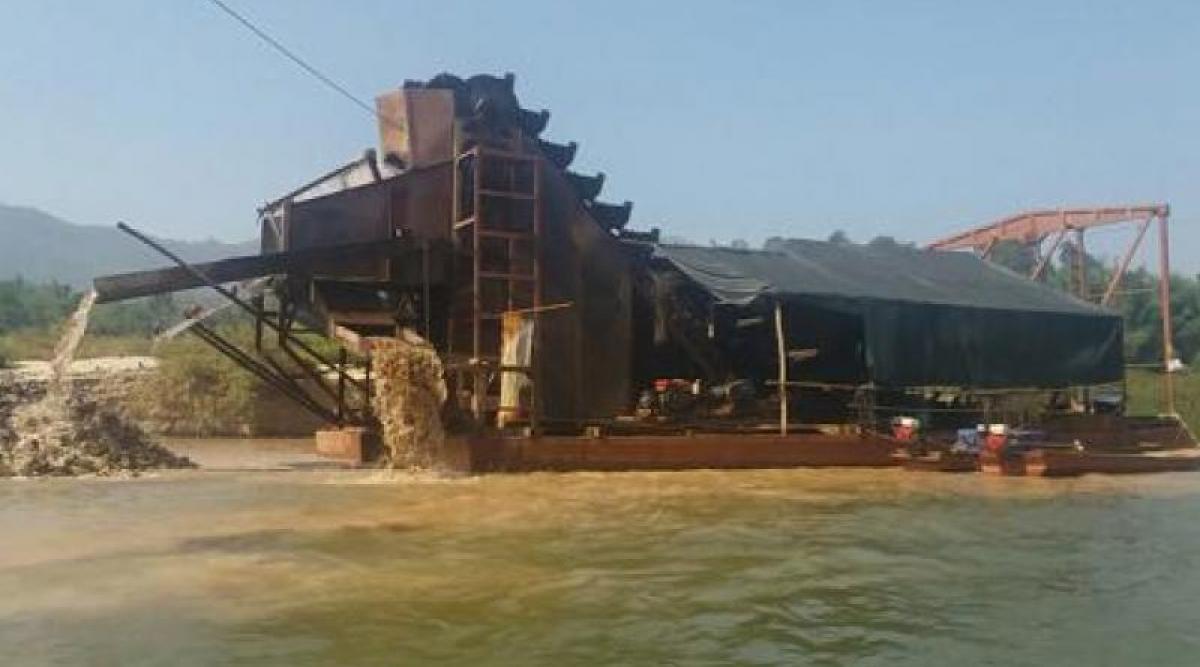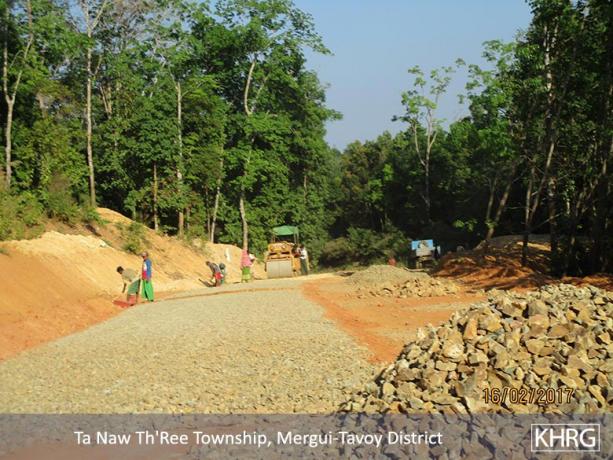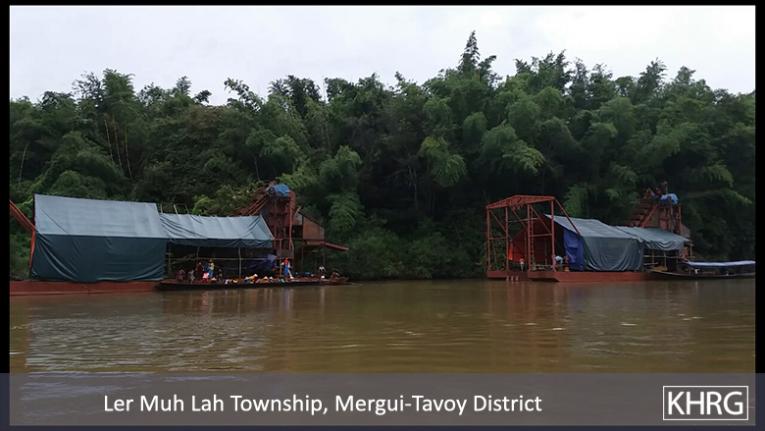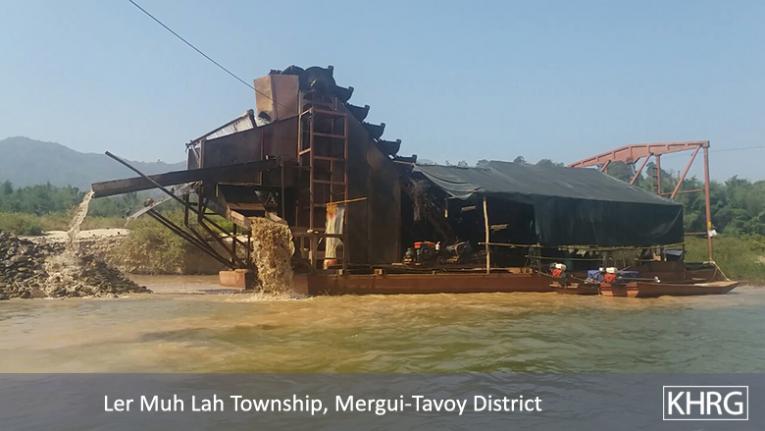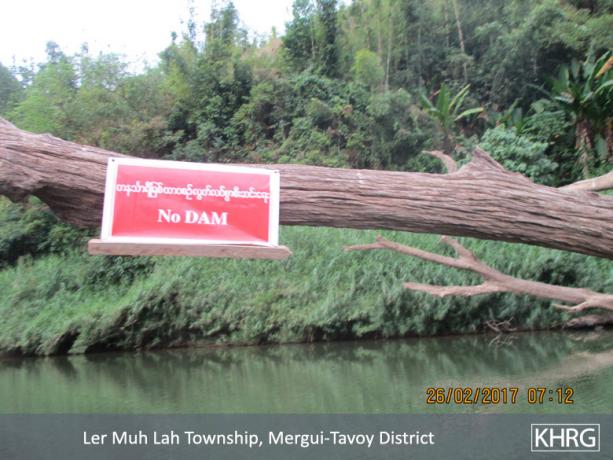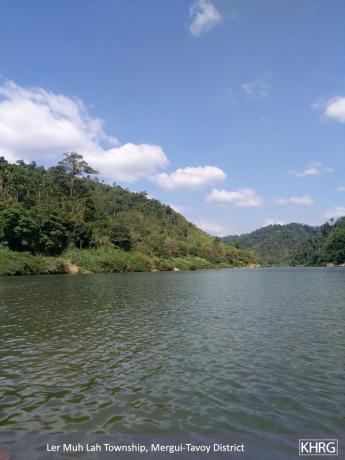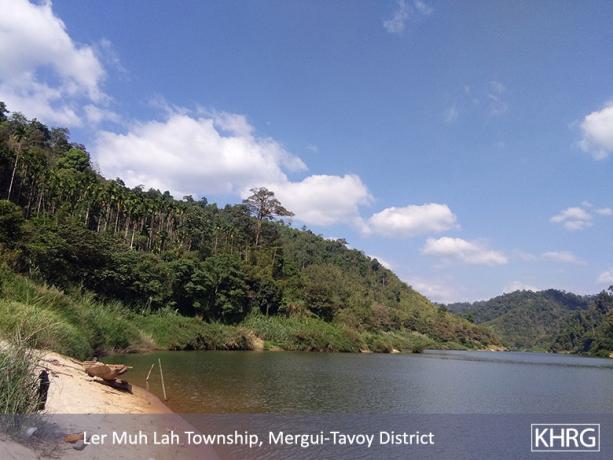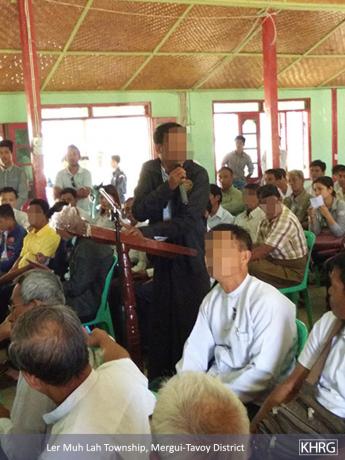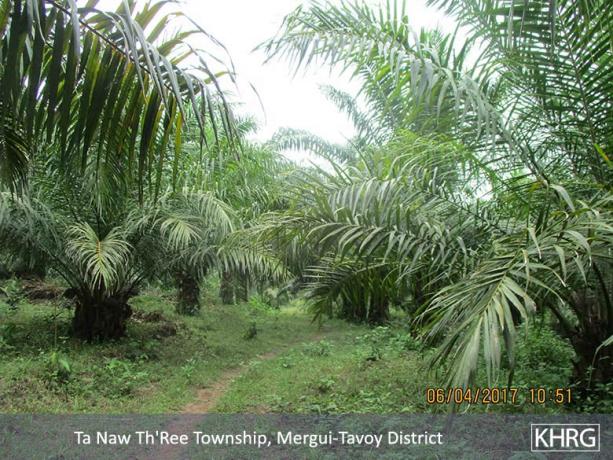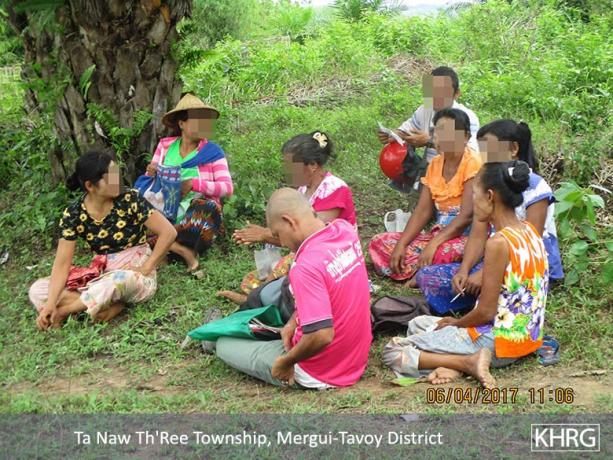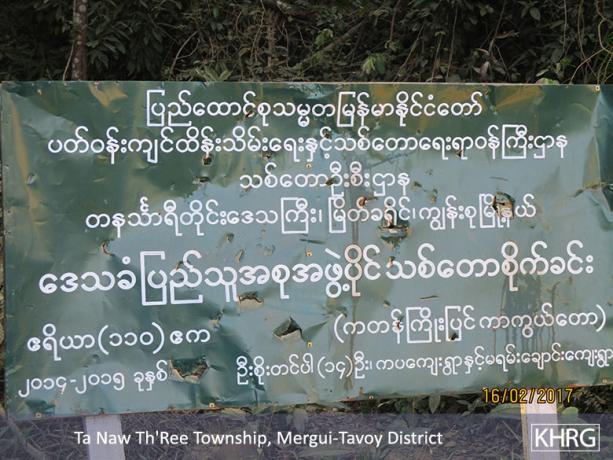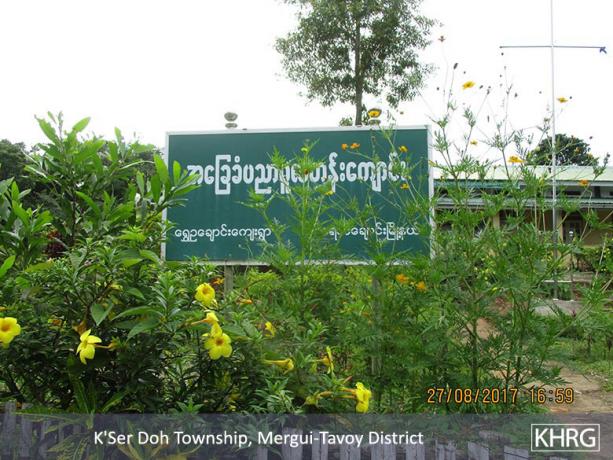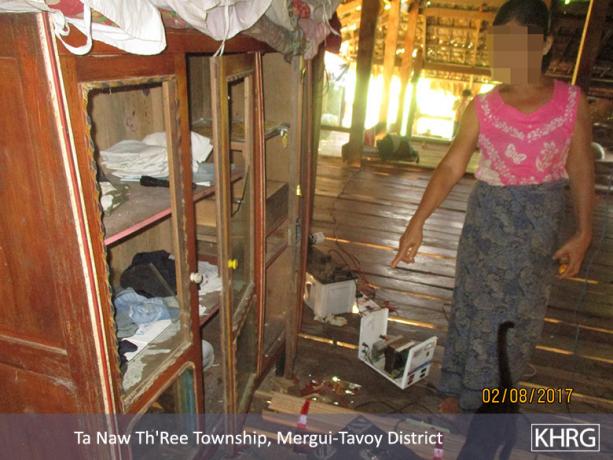This Field Report analyses information collected by KHRG researchers on events that occurred in Mergui-Tavoy District between January 2016 and December 2017. It describes different human rights violations and other issues important to the local community. It includes villagers’ concerns about development projects, land confiscation, military activity, domestic abuse, refugee repatriation, education, healthcare and villagers’ livelihood.
- Local communities in Mergui-Tavoy District are concerned with the increasing number of land confiscations that have occurred after the 2012 preliminary ceasefire agreement. In the past two years, private companies and the Burma/Myanmar government have both confiscated lands from rural communities. Without agricultural land, villagers faced severe livelihoods challenges. A lack of accountability, as well as the absence of proper consultations and compensation, are barriers for villagers trying to reclaim their land. Because powerful actors are involved in land confiscations, villagers are worried for their safety when advocating for their land rights.
- Despite the ceasefire agreements, many refugees in the Tam Hin camp in Thailand are worried to return to Mergui-Tavoy District because of safety concerns and livelihood challenges.
- Villagers reported that fighting and human rights violations have decreased in Mergui-Tavoy District since the 2012 ceasefire agreement. Despite the 2015 Nationwide Ceasefire Agreement, Tatmadaw are still engaged in some military activities, including transporting rations, patrolling near civilian areas, conducting military trainings, and strengthening army camps.
- Since 2015, the Burma/Myanmar government has built many healthcare clinics in Mergui-Tavoy. However, villagers in isolated areas find it difficult to access healthcare services because of a lack of medicines and an insufficient number of health workers.
- Education has not improved in Mergui-Tavoy District since the new Burma/Myanmar government came to power. Children have limited opportunities to learn Karen language. In rural areas, additional barriers to education include a lack of finances and a shortage of teachers.
Introduction
This Field Report from Mergui-Tavoy District[1] analyses information from 36 KHRG reports, including Interviews, Situation Updates, Photo Notes and Incident Reports collected by KHRG field researchers between January 2016 and December 2017. Human rights violations in Mergui-Tavoy District have decreased since the 2015 Nationwide Ceasefire Agreement. However, development-related human rights abuses are on the rise relating to road construction, hydropower dams and agribusiness. Local communities are worried about land confiscation and military activities in Mergui-Tavoy District and concerned by their limited access to education and health services.
Land and Livelihoods
Following the 2015 Nationwide Ceasefire Agreement,[2] development projects and business ventures have rapidly increased in Mergui-Tavoy District. The restrictions on investments have eased with the development of Memorandums of Understanding (MoU) between the KNU and private companies. However, increased investment has led to a rise in development-related abuses. Companies and government authorities rarely adhere to the principle of Free, Prior and Informed Consent (FPIC). Because they do not hold consultations before the implementation of corporate-development projects, development is not inclusive. Rural communities are facing land confiscations, damage to property, a reduction in income, and negative health problems.
Between 2016 and 2017, there are three main types of corporate development projects in Mergui-Tavoy: road construction,[3] mining,[4] and proposed hydropower dam.[5] Land confiscations by private companies are on the rise since the 2015 ceasefire.
Development Projects: Road construction in Mergui-Tavoy District
Many communities in Mergui-Tavoy District welcome the improvements in transport that new roads bring. However, road construction is often linked to human rights violations.
Road construction companies contracted by the Burma/Myanmar government do not seek the consent of local communities. Company representatives do not recognise the land titles of villagers, an additional factor compounding the vulnerability of local communities. This means that villagers are unable to claim compensation for land confiscation or property damage. Local communities are attempting to advocate for their rights by submitting complaint letters to the Burma/Myanmar government. They rarely receive a response for, making it difficult for rural communities to protect their land rights in cases of road construction.
Reports from Mergui-Tavoy show that companies and authorities rarely abide by the principle of Free, Prior, Informed and Consent (FPIC). Rural communities are not consulted about road construction in their areas, even when roads are designed to go through their agricultural lands. They are rarely provided opportunities to seek compensation for damages caused by road construction. This has made it difficult for villagers to benefit from road construction projects. In early 2017, a company built a road in A--- village, Ta Naw Th’Ree Township, Mergui-Tavoy District. Local villagers were not consulted because the company claimed that the Burma/Myanmar government had already granted them permission to construct the road. The road construction destroyed the plantations that many villagers depend on for their livelihoods. In the process of road construction, many rubber trees, cashew nut trees and betel nut trees were cut down. Villagers affected by land confiscation found it difficult to advocate for their land rights because information about the road construction was not readily available. This is a general trend throughout Mergui-Tavoy District. For example, according to an interview received in November 2017, villagers reported that an unknown company started to implement a road construction project in B--- village, Ta Naw Th’Ree Township, but the company did not provide information about the potential impact of the road project to local community members. The road construction damaged agricultural lands and plantations. Infrastructure development in Mergui-Tavoy will not benefit local communities if companies and local authorities do not adhere to the principle of FPIC.
Because rural communities in Mergui-Tavoy rely on customary land practices, it is difficult for them to protect their land rights. However, this customary system is not recognised under Myanmar’s national land laws,[6] which makes it difficult for villagers to claim compensation if their lands are damaged or confiscated. Many villagers in Mergui-Tavoy try to obtain land titles as a way to protect their land. This is difficult because there are two overlapping land governance systems in Mergui-Tavoy: the Burma/Myanmar government system, and the KNU system. Even when villagers successfully obtain land titles, stakeholders often do not recognise them, making it more difficult for them to secure their lands. For example, one of the villager’s lands from C--- village, Ta Naw Th’Ree Township was damaged because the Burma/Myanmar government built a road through his land. When he requested compensation from road constructors by showing his land title, his document was not recognized. He told a KHRG researcher_
“My grandfather worked on this plantation. [When he died], my uncle inherited the plantations and [when he died], I inherited [the plantations]. Therefore, my family has owned this land since a long time ago. I have a land title and a map that I showed to them [the road construction workers] but they just said, ‘It is impossible [to get compensation with your document]’. Therefore, I could not do anything else [for my damaged plantations]. I showed them my land title but they just told me, ‘It is impossible.’”[7]
To respond to land confiscations, villagers attempted to use their agency by confronting the company, submitting complaint letters and reporting cases to the Burma/Myanmar government. These attempts are often unsuccessful. When road construction led to land confiscation in D--- village, villagers submitted information to the Burma/Myanmar government for assistance but they did not receive a response. Companies and local authorities do not respond to the concerns of the local community, suggesting a lack of accountability for cases of land confiscations and land damage.
Rural communities also reported encountering additional challenges due to the poor quality of roads. This makes it difficult for local villagers to travel to their farms and plantation. For instance, villagers in K’Ser Doh Township stated that they have faced transportation challenges because of the poor quality of roads, especially during the rainy season. Rural communities also reported their concerns about the quality of roads to the Burma/Myanmar government in 2016, but did not receive any response so far. The villagers demanded that the Burma/Myanmar government should monitor road construction on the ground in order to improve the quality of road construction.[8] If roads are not of good quality, local communities find it difficult to travel and transport goods for sale.
Development: Coal, Lead and Gold Mining in Mergui-Tavoy District
KHRG received more reports related to mining in Mergui-Tavoy District in 2017 compared to previous years. There are three types of large-scale mining operations conducted in Mergui-Tavoy District: coal, lead, and gold mining. Villagers have faced severe livelihood challenges, negative health consequences and environmental damages due to mining. For this reason, villagers want to suspend or stop the mining for natural resources. Because the KNU authorities have already granted permits for mining, rural communities feel that there is little they can do to protect themselves from the negative impacts of natural resource extraction.
In Mergui-Tavoy District, rural communities do not have a voice in mining operations. They typically occur once private actors receive permission from armed groups, the Burma/Myanmar government, and local KNU authorities. Because the perspectives of local communities are ignored, villagers face barriers when trying to protect themselves from the negative impacts of mining. According to a situation update from K’Ser Doh Township, the East Star Company[10] mined for coal in Paw Klo area in K’Ser Doh Township before the 2012 ceasefire agreement.[11] Although the coal mining damaged the lands of local villagers, the company proceeded because it received permission from the KNU authorities. After the 2012 ceasefire agreement, village leaders and villagers in Paw Klo area held a meeting to try to stop this project. The Mayflower Company, which replaced the East Star Company, held a meeting with local villagers and a Tatmadaw Base commander to respond to their concerns. The company told the villagers that they would proceed with the coal mining since they received permission from KNU authorities. When local community members approached the local KNU leaders to inquire about this, they were told that the Tatmadaw had in fact granted permission to the Mayflower Company to mine. Despite their efforts to protest this situation, the local community was unable to stop the coal mining. Similar to road construction, in many cases involving natural resource extraction, local communities were not consulted before mining operations began. Since February 2017, many companies have been mining a local river in K’Htaw Ni village, Paw Hkloe area, K’Ser Doh Township. A village head was so frustrated with this situation that he wanted to resign from his position. He felt powerless that local businessmen were mining gold from the local river without consulting him or the KNU authorities. In another case, the KNU authorities from Mergui-Tavoy District allowed GMS Power Public Company and Shwey Htun Company to mine for gold, despite opposition from local villagers. Naw Y--- from G--- village, Ler Muh Lah Township stated:
“Which authorities did they get permission from [to conduct the gold mining project]?
They got it [permission] from the Karen National Union [KNU] leaders because the KNU Mergui-Tavoy District Vice Secretary P’Doh Thwoo Yeh talked about the gold mining project in the [consultation] meeting that I attended in April 2017. He said that he granted permission to [the company to] conduct gold mining so the project should not be disrupted by anyone. Nevertheless, civilians are aware of the negative consequences of gold mining so they submitted complaint letters [to both the KNU and the Burma/Myanmar government].”
In cases of natural resource extraction, consultations are especially important for local communities whose health and wellbeing are at risk. The environmental degradation and pollution can negatively impact the lives of entire communities. When the Paw Hkloe River was mined for gold, many chemicals, including mercury, seeped into the water. Communities along the banks of this river suffered when they used water from the river.[12]
“[KHRG researcher] I also received information about companies [GMS Power Public Company and Shwey Htun Company] and wealthy individuals who conducted gold and lead mining polluting the water. Is this correct?
[Villager] Yes, it is correct. When local people conduct gold mining and use the mercury chemical as part of the gold mining process, they do not allow the mercury to flow into the river [Ta Naw Th’Ree River], but they [GMS Power Public Company and Shwey Htun Company] allow lots of the mercury chemical to flow into the river. As mercury is a poisonous chemical used in the gold mining process, it can cause diseases such as kidney failure if we drink water polluted by mercury. Nevertheless, many villagers drink water from the river and local villagers face many illnesses. Moreover, most villagers do not have money to access medical treatment at the hospital. People who have money went to the hospital for medical treatment, but some people died because they did not have money [to access treatment]. Additionally, the ships [of the Shwey Htun and GMS Power Public Company] that conduct gold and lead mining in the river have damaged the river; sand and stone banks created by the project have blocked the route taken by the villagers who travel in the river [by boat]. Thus, we have to pull our boats that are stuck in the sand and stone banks so our travelling time has increased from three hours to the entire day.
[…]
Does the gold mining project provide any benefits for villagers?
There are no benefits for villagers.”
Naw Y--- (Female, unknown age), G--- village, Ler Muh Lah Township, Mergui-Tavoy District
(Interviewed in August 2017)[13]
A similar situation occurred when the Ta Naw Th’Ree River was mined for lead and gold by the GMS Power Public Company and the Shwey Htun Company in Ler Muh Lah Township. These projects only caused environmental damage and health problems for the local community
Development: Building a hydropower dam on the Tanintharyi River
With the signing of a Memorandum of Understanding (MoU) in Mergui-Tavoy District between the KNU and private companies on December 13th 2016,[14] plans have moved forward to build a hydropower dam on the Tanintharyi River.[15]
The Tanintharyi River has been marked as a potential location for the construction of a hydropower dam since 1997. If this dam is built, the river will flood an area of around 585 square kilometres, including 250 square kilometres of plantation land. Local communities are concerned about the flooding, land damage and displacement. However, they face many barriers when advocating for their land rights. This is in part due to the absence of a consultation about the hydropower dam. An additional challenge is the lack of support of KNU leaders for the local population.
The Italian-Thai Development PLC and Burma/Myanmar Government Ministry of Electricity conducted assessments for a proposed hydropower dam project several times in 2011 at Tanintharyi River, G--- village, Ler Mu Lah Township, Mergui-Tavoy District. At the time, they did not provide information about the project to local communities. Villagers from Ler Muh Lah Township are worried that their houses, lands, and plantations will be flooded if the dam is built Many of them do not know how to stop the hydropower dam:
“We attempted to protest against them but if they are serious about implementing the project, we have no idea how the stop them”.
“We strongly disagree with the project but we also do not know how to stand up for our rights. We are in a state of worry about [potentially] losing our land and villages and we seriously do not know how to survive in the future [if that happens]. [We do not know what we will do] if they do not consider for our concern.”
“The dam project makes us very worried. It will become the biggest challenge for our future. We would like organisations [CBOs] to suggest to us how to protect [our villages from] the dam and give awareness [on how to] stop the implementation of the project. Regarding the proposed dam project, KNU leaders have not taken any action for us. We have been able to submit the issue to the KNU leaders but we are not sure whether they will take action or not. We need support from local organisations to suggest how to deal with the project.”
Saw Q--- (male, 28), L--- village, Ler Muh Lah Township, Mergui-Tavoy District (Interviewed in March 2017) [16]
Because authorities in Mergui-Tavoy District work closely with private actors, there are limited opportunities for local communities to voice their opposition. This has not stopped the population from organising protests against the dam and voicing their concerns to company representatives at a consultation on February 9th 2017. [17]
According to a KHRG interview received in March 2017, consultations were not designed in a way to facilitate the participation of the local community. Because the meeting was held in a town a distance away from the villagers impacted by the flooding, many community members were not able to attend:
“Did the villagers who attended the meeting include the representatives of all the 18 villages?
No, some village [representatives] could not reach the meeting because the meeting was held in a town which is very far from their villages. Some villagers [from certain villages] have never been to the town so they didn’t know where to go for the meeting and some of them do not have money [to pay the taxi fee to get to the meeting].”
Saw W---, (Male, unknown age), H--- village, Ler Muh Lah Township, Mergui-Tavoy District
(Interviewed in March 2017)[18]
Consultations should be designed in a way that makes them more accessible to villagers, by holding them at multiple local sites in affected areas, or by compensating villagers for the transport costs for attending consultation meetings. In the absence of meaningful consultations, development projects in Mergui-Tavoy District will not benefit local communities.
Land confiscation and livelihood challenges
“Our [village] lands were inherited from our forefathers and we are poor people so we want to get our land back to us. We [currently] don’t have land to farm for our livelihoods. Therefore, we will have land to farm for our livelihood only when we get our land back to us.”
Saw O---, (male, 35), E--- village, Ta Naw Th’Ree Township, Mergui-Tavoy District
(Interview received in June 2017)[19]
Rural communities in Southeast Myanmar rely on subsistence agriculture. They depend on their ancestral lands to support their livelihoods. When their lands are confiscated, it can make it difficult for villagers to survive. Since the 2012 preliminary ceasefire agreement, land confiscations by government authorities and private companies have increased in Mergui Tavoy-District. Rural communities affected by large-scale land confiscations have encountered livelihood challenges. They face many challenges when advocating for their land rights.
The case of CKB Company[20] in Ta Naw Th’Ree Township highlights how land rights are abused in Mergui-Tavoy District and the efforts that rural communities take to protect themselves from private interests. CKB Company confiscated 325 acres of land from 27 villagers in Ta Naw Th’Ree Township during the conflict period. Their goal was to develop a palm oil plantation. CKB Company forced villagers to leave their homes. After confiscating the land, CKB Company cut down the villagers’ trees. In 2017, villagers have not regained their lands. CKB Company is still planting palm oil trees on the confiscated land.[21]
Local community members submitted a complaint letter to the KNU about this case. The KNU recorded the number of acres that were confiscated and reported the issue to the Forestry Department of the Burma/Myanmar government. The Forestry Department of the Burma/Myanmar government promised it would investigate this case further. However, they did not take any concrete actions to resolve this situation. Local community members formed a committee to advocate for their rights. This committee has about 10 members, who are working to reclaim the land and receive compensation for their loss.[22] The villagers affected by this land confiscation also reported this incident to authorities from the National League for Democracy, but they received no reply. It is difficult for villagers to advocate for their land rights because their voices are not recognised.
Another example of land confiscation is the case of Pyi Phyo Htun Company, a company that developed a rubber plantation in K’Ser Doh Township, Mergui-Tavoy District. The Pyi Phyo Htun Company confiscated land from more than 40 villagers in Kleh Mu Hti village tract, K’Ser Doh Township in 2005. Those villagers continue to suffer from this land confiscation today. In total, approximately 800 acres of vacant land and 500 acres of plantations were confiscated, including betel nut, coconut, cashew, and rubber plants. Compensation was distributed unevenly. The amount of compensation that the company offered did not meet villagers’ demands. Instead, villagers were also forced to accept the compensation on the terms of the company. Because villagers used this land for their plantations and to raise their animals, they faced food insecurity after their land was confiscated.[23]
“If you do not get your land back, what will you do?
Most of the people in this area are poor. If I do not get my land back, I do not have [other] land to work on and I cannot work on other people’s farms as a daily labourer because they are all located very far from us [villagers]. I would like to request the KNU and the Burma/Myanmar government to work together and investigate this case so we will get our land back. I just want my land back and to be able to work for my family’s livelihood.”
Saw X---, (Male, unknown age), I--- village, Ta Naw Th’Ree Township, Mergui-Tavoy District
(Interviewed in August 2017)[24]
The Burma/Myanmar government was also responsible for confiscation of land for the purposes of developing agribusiness. Burma/Myanmar government workers came to K’Pa village and Ma Yan Chaung village, Ta Naw Th’Ree Township, Mergui-Tavoy District in 2017. They put a signboard up to declare 110 acres of villagers’ land as their own. This land was defined as a ‘community reserved forest’ in a project led by the Forestry Department. Burma/Myanmar government workers planted teak plantations on the confiscated land without consulting village leaders or the local community. No compensation was given to owners of the confiscated land. Villagers were worried about fighting for their land rights because the village tract administrators and land department administrators were involved in the land confiscation. This is one of many barriers villagers face when advocating for their land rights.[25]
Environment and livelihood challenges
The majority of local villagers from Mergui-Tavoy District work on plantations, hill farms and plain farms to secure their livelihoods. In 2016 and 2017, villagers reported that they face livelihood challenges mainly due to unpredictable weather conditions, unstable commodity prices, and insect infestations.
Environmental changes are making it more difficult for local communities to secure their livelihoods. In 2016, villagers from K’Ser Doh Township were unable to generate income from their betel nut plantation because of high temperatures. During the rainy season, rural communities had difficulties growing their rice paddies because there was insufficient rain. Because of rains in the winter season, villagers could not reap their harvests. Some crops were eaten by insects, making it difficult for villagers to replant paddy. Villagers from Ler Muh Lah Township also faced livelihood challenges due to the unfavourable weather in 2016. Their paddy fields were flooded in the winter due to rain and insects destroyed their paddy plants. Some villagers had to replant their paddy three times in one year because of the damage caused by insects and flooding. [26] Because of the difficult environmental conditions, many rural households in K’Ser Doh and Ler Muh Lah Townships needed livelihood support from the Burma/Myanmar government and the KNU. It is important to build their resilience to environmental changes.
Local communities are also vulnerable to the fluctuations of commodity prices. A number of villagers rely on rubber plantations to earn their living in Dawei Khee village tract, Ler Doh Soh Township. In 2016, it was difficult for them to sustain their livelihoods because the price of rubber decreased.[27] This was compounded by a decrease in the price of rice in 2017.[28]
Militarisation and refugee repatriation
KHRG has received six Situation Updates about militarisation from Mergui-Tavoy District from 2016 to 2017. These reports include information about the transport of military rations, military patrols near villages, and military trainings. According to villagers’ testimonies, violent conflict and human rights violations have decreased after the 2012 ceasefire agreement. However, in certain areas of Mergui-Tavoy District, villagers believe that some Tatmadaw military activities have increased since the 2015 Nationwide Ceasefire Agreement.
Villagers reported that they faced livelihood challenges and safety concerns due to the impact of Tatmadaw military activities.[29] Some villagers reported that Tatmadaw increased their movement and military activities when they were reconstructing their army camps. For example, the Tatmadaw conducted military trainings in P’Soh Oo village and near P’Nweh Hpoh Kloh village, P’Law area, Ler Muh Lah Township. The military training lasted from November 2015 to January 2016. They patrolled around the local villages. On January 7th 2016, the Tatmadaw also transported 20 military trucks worth of rations to their army camp in Naw Teh village, Ler Muh Lah Township. This was problematic because Naw Teh village is in a KNU controlled area, and the Tatmadaw transported these rations without informing the KNU or the KNLA.[30] This military activity violated the NCA Code of Conduct, specifically Article 8, Section B which specifies that the movement of armed troops in areas controlled by the other armed group is allowed only after obtaining prior agreement. Local communities are concerned about these activities because they perceive that fighting can break out any time due to Tatmadaw activities.
During the period between February and April 2017, the Tatmadaw conducted military trainings in Ler Doh Soh and K’Ser Doh Townships. During the military training, the Tatmadaw shot at villagers’ lands with artillery. In this training, livestock belonging to local villagers were accidentally shot. The Tatmadaw did not take any responsibility for this action. Villagers were unhappy that the Tatmadaw did not take any responsibility for the security of the local community.[31]
Refugee Repatriation
Many refugees from Tham Hin refugee camp have been repatriated to Mergui-Tavoy District and other parts of Southeast Myanmar. Tham Hin refugee camp was established in May 1997 when thousands of rural villagers from Mergui-Tavoy District fled their homes after a Tatmadaw offensive. More than thirty years later, refugees in Thailand have started to return to their former villages in Karen State. KHRG and other organisations along the Thai-Burma border have continued to monitor this situation. KHRG has found that refugees from Tham Hin refugee camp are uneasy about the prospect of returning to Myanmar because of ongoing militarisation and potential livelihood challenges. [32]
Hpuh V---, a member of the Tham Hin refugee camp committee, told a KHRG researcher from Mergui-Tavoy District about the refugee repatriation process, “Both the UNHCR [United Nations High Commissioner for Refugees] and the NGOs [Non-Government Organisations] always question us about whether we want to return or not. According to the UNHCR and the NGOs, we have to tell them if we can return [if it is possible] and when we should return [when it is appropriate]. As for us, we do not want to return because we know that there is instability [in Burma/Myanmar]”.[33]
According to interviews conducted in Tham Hin refugee camp, the Thai government told refugees: “You can return. We have already discussed and made an agreement with the Burma/Myanmar government”. Nevertheless, refugees continue to worry about their safety if they return to their villages in Myanmar. Many of them are concerned about the presence of Tatmadaw army camps near their villages and are advocating for the removal of Tatmadaw military bases near civilian areas.
Some refugees have temporarily returned to live in their villages without informing camp authorities. Their goal was to maintain and cultivate their lands. They reported that they do not have any opportunities to earn a living in Tham Hin refugee camp. They found it difficult to sustain a livelihood because their food rations were also regularly reduced. They are worried about their livelihoods and their children’s education. This is what prompted them to return to their villages to do farming and work on banana and chilli pepper plantations. They sold their crops to get income to support their livelihoods and their family members who still live in Tham Hin refugee camp.
Lay Lit, the Secretary of the Karen Student Network Group told Burma Link about the root causes of refugee return: “the rations and all the support from TBC (The Border Consortium) — everything is reduced. They reduce rations every day [all the time]. That is why there are a lot of problems. I mean international community who have already supported the refugees in the past, like they supported a lot in the camp, but because they reduced their support, refugees go back. Like some NGOs now they support in Burma and support some other organizations in Burma. But they reduced the support for the refugee camps … that is why the “voluntary” return is happening”.[34]
Saw Htoo Htoo Stin, the president of the Karen Student Network Group, told Burma Link that the current situation in Southeast Myanmar is not stable enough for refugees to return: “Most of the donors that support the refugees, they put pressure on the refugees to return, because they believe that there is peace in Burma. But in reality, peace is just skin deep, it’s not going very deep. We would like to request the donors to keep on supporting the youth and refugees.”[35]
Many refugees do not feel that they have the choice to return to Burma/Myanmar. Naw U---, a refugee from Tham Hin refugee camp who briefly returned to her village in Mergui-Tavoy District, expressed her feelings towards the peace process: “I am still afraid of Burmese army [Tatmadaw] and I do not believe in them because they are unreliable to me. My concern is: if I cannot live in my village because of fighting after I leave the camp and then what I can do if I cannot live in the camp either. I will not know where I have to go when I am at the centre [among the difficulties around me and have no choice]. Refugees want to return but they do not dare to come back because they are afraid of Burmese [Tatmadaw] and they worry that the conflict will happen between KNLA and Tatmadaw again. They [KNU and Burma/Myanmar government] signed the ceasefire agreement and I come back [to my area], but I just live in fear.”[36]
Hpuh V--- also stated refugees from Than Hin refugee camp requested for housing, security, livelihoods, education and healthcare arrangements to support repatriation. They advocated to the United Nations High Commissioner for Refugees, relevant Non-Governmental Organisations and the Karen National Union for help. If they choose to return, they would like to do so with safety and dignity.[37]
Healthcare
Since the 2015 NCA, more clinics have been constructed in Mergui-Tavoy District. However, it is still challenging for rural communities to access healthcare services. The three main barriers include the high cost of healthcare, instances of discrimination against villagers, and the frequent absence of healthcare workers.
There are two parallel health care systems in Mergui-Tavoy District: one provided by the Burma/Myanmar government, and another by the Karen National Union. Rural communities have reported to KHRG that it is easier for them to access healthcare services from the KNU. This is because medical services are free from KNU clinics, in contrast to Burma/Myanmar government clinics:
“In 2017, villagers cannot easily find help from the Burma/Myanmar government-assigned healthcare workers when they have their health issues[38] because villagers face financial challenges when they go to get medical treatment from the Burma/Myanmar government’s clinic as they are poor. On the other hand, it is free to receive medical service from the KNU’s clinic.”[39]
“If sick villagers wanted to get medical treatment, they had to pay the healthcare services fee. Thus, villagers who live in rural villages cannot have healthcare services as they face financial problems. The Burma/Myanmar government provides access to vaccinations in villages one time per month; however, only children can get vaccinated. There is no free healthcare service for old people.”[40]
Rural communities also found it difficult to receive proper medical treatment from Burma/Myanmar hospitals. They felt that they were not treated fairly because they were from a vulnerable socio-economic background. Villagers believed that health workers gave preferential treatment to wealthy individuals. In one case, a local villager was seriously sick and went to the hospital for medical treatment. He felt that he was denied treatment because of his background. A nurse told him,
“The time is up for the medical treatment and we could not provide any medical treatment without the order of the doctor”. Regarding this situation, he said, “One day, I went to the hospital as I had an urgent sickness, and I arrived in hospital at 12:30 am [midnight]. A nurse told me that the time is out and they do not give any medical treatment for the outsider but only the patient who already stayed in the hospital. Then I suffered the whole night without getting any treatment. In the morning, I went again taking my medical treatment card but I did not get any treatment”.[41]
Rural communities in Mergui-Tavoy District also reported that they could not access healthcare services because local clinics were severely understaffed. A 2017 Situation Update from KHRG explains the impacts of this problem:
“There is a female health worker and a clinic in La Baw area, in K’Ser Doh Township which is built and hired by the Burma/Myanmar government, but villagers do not have healthcare services at the clinic due to the frequent absence of health workers. There are no health workers in some areas in K’Ser Doh Township so villagers have to buy medicine from the local pharmacy when their children have a cough but some medicines from the pharmacy are ineffective.”[42]
In this situation, rural communities cannot afford proper consultations with medical professionals at clinics or hospitals. Instead, they rely on medications bought in local pharmacies, without receiving a professional diagnosis.
Education
Rural communities reported that education has not improved in Mergui-Tavoy District since the 2015 Nationwide Ceasefire Agreement. Children in rural areas face three main educational challenges: limited opportunities to learn in Karen, difficulties accessing education because of financial issues, and a shortage of teachers.
In Mergui-Tavoy District, there are limited opportunities for Karen students to learn in the Karen language in Burma/Myanmar government schools. Although the Karen language is permitted in certain schools, it is generally not used as a language of study in middle schools and high schools in Mergui-Tavoy District. [43] In primary schools, Karen language is taught for one period a week. Most students learn Karen language on Saturday, outside of school hours. In some schools, Karen culture is suppressed and Karen clothes are not allowed. To resolve this situation, local authorities requested that the Karen language is taught during school hours and that Karen clothes would be allowed one day per week. They appealed to school principals, Township education administrators and District administrators. However, Township and District authorities told local authorities: “We cannot allow you to practice it [your own culture] without permission from Naypyidaw [national Burma/Myanmar government]”.[44] Because of this, Karen communities in Mergui-Tavoy feel that the Burma/Myanmar government does not recognise their language or culture.
“The Karen language is not recognised by the Burma/Myanmar government [as a mandatory subject] to teach in most schools. Karen teachers only have the opportunity to teach the Karen subject class [in the early morning] before school begins. In some schools, the Karen subject class is only allowed to be taught on Fridays. Therefore, [Karen] students have to work outside school hours and use the extra time in order to learn their language.”
Situation Update from K’Ser Doh, Mergui-Tavoy District
(Published in February 2018)[45]
Rural children face difficulties accessing education in Burma/Myanmar government schools because high schools are primarily located in towns. For example, although there are many primary schools in the KNU controlled area in Ta Naw Th’Ree Township, there is only one high school. These schools have a mixture of Burma/Myanmar government teachers and local Karen teachers. In primary schools, the Karen Education Department [KED] provides free school materials to students, including school uniforms, pens, pencils and notebooks. When primary school students from rural areas want to continue their education in Burma/Myanmar government high schools in the local town, they face significant financial barriers. Because they cannot afford tuition fees, many students are not able to continue with their education.
Most schools in Karen villages have a shortage of teachers. Villagers in K’Ser Doh Township reported that some schools only have a teacher or a principal on staff, while some have both. The primary school in M--- village used to have three teachers for 59 students. Two of them were from the Burma/Myanmar government. However, the school principal U T--- explained that when they applied to teach elsewhere, they face a problem getting new teachers to replace them:
“There is only one principal and one female teacher in my school so we face major teaching challenges. I had three other [Burma/Myanmar government] teachers last year, but they applied to teach and take on responsibilities in other areas this year and there were no other teachers available to replace them. Therefore, we faced a difficult situation.”
Many rural schools face difficulties securing substitute teachers:
“Students’ studies are also interrupted because teachers take long paternity/maternity leaves when their delivery date is close and the Burma/Myanmar government [education department] does not then provide substitute teachers. Therefore, village leaders and villagers have to both find a substitute teacher and pay their salary, which burdens villagers”.
Situation Update from K’Ser Doh Township, Mergui-Tavoy District
(Published in December 2017)[46]
Domestic violence
KHRG has received an increase in reports of domestic abuse and drug use in Mergui-Tavoy District. Consequently, it has affected the local community and resulted in fear and insecurity. The KNU police officers and the Burma/Myanmar government police officers tried to solve these problems in local communities but some issues remain.
KHRG received a report regarding an incident of domestic abuse in August 2017. Saw Kyaw Way from N--- village, Doo P’Leh Oh Klaw Hko area, Ta Naw Th’Ree Township was addicted to yaba and crystal yaba. When he was under the influence of drugs, he lost his self-control. He sold his mother’s belongings, including her cows and the motor from her boat, to finance his drug addiction. When he was under the influence of yaba, he destroyed his family’s belongings, including their TV and wardrobe. He also threatened and attempted to murder his mother, Naw S---. His mother did not feel safe to continue living with Saw Kyaw Way. She reported the incident to KNU police officers. On August 2nd 2017, Saw Kyaw Way was arrested. He was detained at a Karen National Union police station. Lieutenant Saw R--- said, “Regarding this [drug] case, Saw Kyaw Win has to be sentenced to at least three years of prison.”[47]
A KHRG researcher in K’Ser Doh Township reported another case of domestic abuse in January 2017. According to Saw Aa--- who lives in Bb--- village, Kleh Mu Hti village tract, K’Ser Doh Township, there was a case of domestic violence in Ae--- village, K’Ser Doh Township.
When Uncle Saw Hkwar Hkwar got drunk, he fought with his family in front of his neighbours’ house. When a villager told him not to cause problems, he responded: “I am not afraid of anyone because I have leaders and I am a Kaw Thoo Lei soldier (KNLA soldier)”. He had an M16 gun and more than 10 bullets with him, which was given to him by his Company Commander. When he got drunk, he warned people that he would give them a drink of M16 bullets. On the night of January 3rd 2017, he got drunk and argued with his wife and children. He was violent and attempted to stab his son. Because of these incidents of domestic violence, his son and wife are worried for their safety. This case of domestic violence also disturbed other the community as a whole.[48]
Conclusion
Although the situation in Mergui-Tavoy District has improved since the 2012 preliminary ceasefire, serious concerns about human rights remain. Between 2016 and 2017, KHRG has received many reports about human rights abuses related to corporate development projects. Land confiscations are an important issue for rural communities in Mergui-Tavoy District. To increase tenure security, the Burma/Myanmar government, local authorities and companies should respect the principle of Free, Prior and Informed Consent. By holding meaningful consultations, businesses can ensure that fair compensation is provided to local community members impacted by land confiscations and land damage.
Militarisation is an additional concern for rural communities in Mergui-Tavoy District. Since the 2015 National Ceasefire Agreement, the Tatmadaw have increased their military activities. They have reconstructed army camps, conducted military trainings, and patrolled in proximity to civilian areas. The Tatmadaw also disrespected the NCA Code of Conduct by trespassing into KNU delimited areas without informing the local KNU authorities. Local communities were worried by these incidents. In order to promote peace in Mergui-Tavoy District, the Tatmadaw should follow the NCA Code of Conduct and provide protection to local communities.
Health and education services in Mergui-Tavoy District have improved during the reporting period, but significant issues remain. Rural communities reported that health clinics and schools were under-staffed. These services lacked financial support from the Burma/Myanmar government and the KNU. Local community members found it difficult to access education and health services because of their high cost. The Myanmar/Burma government and KNU should financially support healthcare and education services throughout Mergui-Tavoy District to ensure that all community members have access to primary and secondary education and basic health services.
Footnotes:
[1]Mergui-Tavoy District is a mixed-control area under the Karen National Union (KNU) and Burma/Myanmar government. Therefore, townships in Mergui-Tavoy District are defined differently by both administrations. The KNU defines five townships in Mergui-Tavoy District, which are K’Ser Doh, Ler Muh Lah, Ta Naw Th’Ree, Ler Doh Soh and Htee Moh Pgha townships, whereas, according to the Burma/Myanmar government defined territory, there are nine townships in Mergui-Tavoy District: Thayatchaung, Dawei, Myaik, Tanintharyi, Kyunsu, Kawthoung Bokpyin , Yaypyu and Launglon. Mergui-Tavoy District is also called Tanintharyi Region [according to Burma/Myanmar government classification] and is located in the southern region of Burma/Myanmar. The Burma/Myanmar government defines the region’s capital as Dawei.
[2] On October 15th 2015, after a negotiation process marred with controversy over the notable non-inclusion of several ethnic armed groups and on-going conflicts in ethnic regions, a Nationwide Ceasefire Agreement (NCA) was signed between the Burma/Myanmar government and eight of the fifteen ethnic armed groups originally invited to the negotiation table, including the KNU, see “Myanmar signs ceasefire with eight armed groups,” Reuters, October 15th 2015. Despite the signing of the NCA prompting a positive response from the international community, see “Myanmar: UN chief welcomes ‘milestone’ signing of ceasefire agreement,” UN News Centre, October 15th 2015, KNU Chairman General Saw Mutu Say Poe’s decision to sign has been met with strong opposition from other members of the Karen armed resistance and civil society groups alike, who believe the decision to be undemocratic and the NCA itself to be a superficial agreement that risks undermining a genuine peace process, see “Without Real Political Roadmap, Nationwide Ceasefire Agreement Leads Nowhere...,” Karen News, September 1st 2015. The signing of the NCA followed the January 12th 2012 preliminary ceasefire agreement between the KNU and Burma/Myanmar government in Hpa-an. For KHRG's analysis of changes in human rights conditions since the preliminary ceasefire, see Truce or Transition? Trends in human rights abuse and local response since the 2012 ceasefire, KHRG, May 2014.
[3] This information was taken from “Mergui-Tavoy Situation Update: Ta Naw Th’Ree Township, 2017” KHRG, July 2017.
[4] This information was taken from “Mergui-Tavoy Interview: Naw A---, August 2017” KHRG, December 2017.
[5] This information was taken from “Mergui-Tavoy Interview: Saw A---, March 2017” KHRG, September 2017.
[6]In Myanmar, all lands are owned by the union of Myanmar government according to Section 37, Sub-Section (a), in Chapter I of the Basic Principles of the Union of State Constitution (2008). A land title is owned by Myanmar government, but it can be transferred by individuals, used for any legal purpose, and constitutes most individual holdings in urban areas. A lease can range from 10 to 90 years, and be extended and no limits exist on selling the land rant to other Myanmar nationals.
[7] This information was taken from “Mergui-Tavoy Interview: Saw A---, February 2017” KHRG, September 2017.
[8] This information was taken from “Mergui-Tavoy Situation Update: K’Ser Doh Township, June to September 2017” KHRG, December 2017.
[9] All conversion estimates for the kyat in this report are based on the 9 May 2015 official market rate of 1,343 kyats to US $1.
[10] This information was taken from “Mergui-Tavoy Interview: Naw A---, August 2017”, KHRG, December 2017.
[11] On January 12th 2012, a preliminary ceasefire agreement was signed between the KNU and Burma/Myanmar government in Hpa-an. Negotiations for a longer-term peace plan are still under way. For updates on the peace process, see the KNU Stakeholder webpage on the Myanmar Peace Monitor website. For KHRG's analysis of changes in human rights conditions since the ceasefire, see Truce or Transition? Trends in human rights abuse and local response since the 2012 ceasefire, KHRG, May 2014. In March 2015, the seventh round of the negotiations for a national ceasefire between the Burma/Myanmar government and various ethnic armed actors began in Yangon, see “Seventh Round of Nationwide Ceasefire Negotiations,” Karen National Union Headquarters, March 18th 2015. Following the negotiations, the KNU held a central standing committee emergency, see “KNU: Emergency Meeting Called To Discuss Nationwide Ceasefire Agreement And Ethnic Leaders’ Summit,” Karen News, April 22nd 2015.
[12] This information is taken from an unpublished report from K’Ser Doh Township received in June 2017.
[13] This information was taken from “Mergui-Tavoy Interview: Naw A---, August 2017” KHRG, December 2017.
[14] Civil society groups strongly disagreed with this Memorandum, see, “Tanintharyi Development Projects Must not Proceed without Transparency and Accountability” December 2016.
[15] The dam will be constructed 2.7 kilometers away from the upper part of Moh Roh village. The hydropower dam project would have the capacity to produce 1040 megawatts (MW) of electric power from the Tanintharyi River.
[16] This information was taken from “Proposed Hydropower Dam Project in Tanintharyi Region, Mergui-Tavoy District, 2017”, KHRG, June 2017 and “Mergui-Tavoy Interview: Saw A---, March 2017” KHRG, September 2017.
[17]This information was taken from “Proposed Hydropower Dam Project in Tanintharyi Region, Mergui-Tavoy District, 2017”, KHRG, June 2017.
[18] This information was taken from “Mergui-Tavoy Interview: Saw A---, March 2017” KHRG, September 2017.
[19] This information was taken from “Mergui-Tavoy Interview: Saw A---, February 2017” KHRG, September 2017.
[20] CKB is a branch of the Green Dragon Myanmar Company, owned by U Bo Sein. CKB Company states on its website that it has 20,000 acres of palm oil plantation and an additional 3,500 acres for further planting in Mergui-Tavoy District. See “GREEN MYANMAR DRAGON”.
[21] This information was taken from “Mergui-Tavoy Situation Update: Ta Naw Th’Ree Township, 2017”, KHRG, July 2017.
[22] This information is taken from an unpublished report from Ta Naw Th’Ree Township received in November 2017.
[23] This information is taken from an unpublished report from K’Ser Doh Township received in January 2017.
[24] “Mergui-Tavoy Interview: Saw A---, February 2017”, KHRG, September 2017.
[25] “Mergui-Tavoy Interview: Saw A---, February 2017”, KHRG, September 2017.
[26] “Mergui-Tavoy Situation Update: K’Ser Doh Township, January 2017”, KHRG, June 2017.
[27] This information is taken from an unpublished report from Ler Doh Soh Township received in March 2016.
[28] This information is taken from an unpublished report from Ler Doh Soh Township received in November 2017.
[29] Tatmadaw refers to the Myanmar military throughout KHRG's 25 year reporting period. The Myanmar military were commonly referred to by villagers in KHRG research areas as SLORC (State Law and Order Restoration Council) from 1988 to 1997 and SPDC (State Peace and Development Council) from 1998 to 2011, which were the Tatmadaw-proclaimed names of the military government of Burma. Villagers also refer to Tatmadaw in some cases as simply "Burmese" or "Burmese soldiers".
[30] This information was taken from “Mergui-Tavoy Situation Update: Ler Muh Lah Township, November 2015 to January 2016”, KHRG, August 2017.
[31] This information was taken from “Mergui-Tavoy Situation Update: Ler Doh Soh Township and K’Ser Doh Township, February to April 2017”, KHRG, February 2018.
[32] Tham Hin refugee camp is one of the nine refugee camps, which is located in Suan Pueng District, Ratchaburi Province, Thailand approximately 12 kilometres from the Thai-Myanmar border. Tham Hin refugee camp is the nearest camp to Mergui-Tavoy District and the closest camp to the border of Burma/Myanmar. The majority of Tham Hin refugees are Karen; other ethnic minorities include Barman and Mon. There were 6,167 refugees in Tham Hin refugee camp in September 2017. In 2005, the Thai government gave approval for resettlement opportunities to be offered to refugees from nine refugee camps. This information is taken from “Thailand: Tham Hin Temporary Shelter Profile (September 2017)
[33] This information is taken from “Mergui-Tavoy Interview: Hpuh A---, January 2017” KHRG, October 2017.
[34] This information is taken from “‘They Reduced the Support for the Refugee Camps … That Is Why the ‘Voluntary’ Return Is Happening’: Lay Lit, Secretary of KSNG”.
[35] This information is taken from “Not Safe for the Refugees to Return”: Karen Students Release Their Position on Repatriation”.
[36] This information was taken from an unpublished report from Ta Naw Th’Ree Township received in March 2017.
[37] For more information on necessary conditions for return, please see ‘Displacement and return’ chapter from “Foundation of Fear: 25 years of villagers' voices from southeast Myanmar” KHRG, October 2017.
[38] This information is taken from an unpublished report from Ler Doh Soh Township received in March 2016.
[39] “Mergui-Tavoy Situation Update: Ler Muh Lah Township, November 2015 to January 2016”, KHRG, August 2016.
[40] This information is taken from two unpublished reports and one published report from Ta Naw Th’Ree Township received in 2017.
[41] This information is taken from an unpublished report from K’Ser Doh Township received in November 2017.
[42]“Mergui-Tavoy Situation Update: K’Ser Doh Township, June to September 2017”, KHRG, December 2017.
[43] “Mergui-Tavoy Situation Update: Ta Naw Th’Ree Township, 2017”, KHRG, July 2017.
[44] “Mergui-Tavoy Situation Update: K’Ser Doh Township, January 2017”, KHRG, June 2017.
[45] “Mergui-Tavoy Situation Update: Ler Doh Soh Township and K’Ser Doh Township, February to April 2017”, KHRG, February 2018.
[46] “Mergui-Tavoy Situation Update: K’Ser Doh Township, June to September 2017”, KHRG, December 2017.
[47] “Mergui-Tavoy Incident Report: Domestic abuse and attempted murder in Ta Naw Th’Ree Township, August 2017” ,KHRG, January 2018.
[48] This information is taken from an unpublished report from K’Ser Doh Township received in January 2017.

